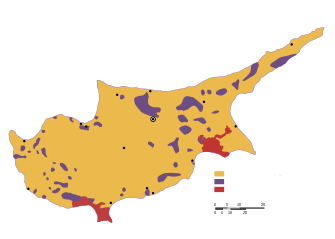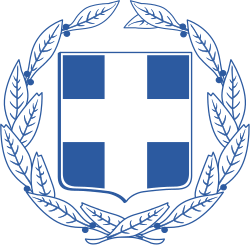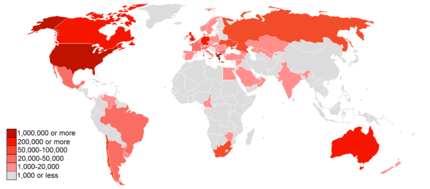Greek Cypriots
| Ελληνοκύπριοι | |
|---|---|
| Total population | |
| c. 1,150,000[1] | |
| Regions with significant populations | |
| 690,000[2] | |
| 270,000[1] | |
| 9,115[3] | |
| 4,815[4] | |
| 9,730–13,850 (Cyprus-born)[5] | |
| Languages | |
| Modern Greek (Cypriot and Standard) | |
| Religion | |
| † Greek Orthodox | |
Greek Cypriots (Greek: Ελληνοκύπριοι) are the ethnic Greek population of Cyprus,[6][7][8][9] forming the island's largest ethnolinguistic community at 78% of the population.[10] Greek Cypriots are mostly members of the Church of Cyprus, an autocephalous Greek Orthodox Church within the wider communion of Orthodox Christianity.[8][11] In regard to the 1960 Constitution of Cyprus, the term also includes Arabic-speaking Maronites, Armenians and Latin Rite Catholics ("Latins"), who were given the option of being included in one or other of the two constituent communities (Greek or Turkish) and voted to join the Greek Cypriot community.
History
Prehistory and Antiquity
Cyprus was part of the Mycenaean civilization, with local production of Mycenaean vases dating to the Late Helladic III (1400–1050 BC). The quantity of this pottery concludes that there were numerous Mycenaean settlers, if not settlements, on the island.[12] Archaeological evidence shows that Greek settlement began unsystematically in ca. 1400 BC, then steadied (possibly due to Dorian invaders on the mainland) with definite settlements established in ca. 1200 BC.[13] The close connection between the Arcadian dialect and those of Pamphylia and Cyprus indicates that the migration came from Achaea.[14] The Achaean tribe may have been an original population of the Peloponnese, Pamphylia, and Cyprus, living in the latter prior to the Dorian invasion, and not a subsequent immigrant group; the Doric elements in Arcadian are lacking in Cypriot.[14] Achaeans settled among the old population, and founded Salamis.[15] The epic Cypria, dating to the 7th century BC, may have originated in Cyprus.[16]
The majority of Greek Cypriots descend from the Achaeans (particularly from Arcadia) but also from the other three Greek tribes: Ionians, Aeolians and Dorians. Throughout the history of Cyprus, Greek people continuously colonized the island from different parts of the Hellenic world. Cyprus is the third largest island in the Mediterranean after Sicily and Sardinia, and the largest island in the eastern Mediterranean. Mount Olympus (also known as Chionistra), the highest point of the Troodos Mountains (1952 m), is the highest point on the island. The island gradually became part of the Hellenic world as the settlers prospered over the next centuries. Alexander the Great conquered the island from the Persians in 333 BC. After the division of the Roman Empire in 285 AD, Cypriots had home rule for almost nine centuries under the jurisdiction of the Byzantine Empire, something not seen again until 1960. Perhaps the most important event of the early Byzantine period was the local church's independence from the Patriarchate of Antioch and All the East in 431. The bishop of the ancient capital Salamis (renamed Constantia by Emperor Constantius II) was constituted metropolitan by Emperor Zeno, with the title archbishop.
Middle Ages
The Byzantine era profoundly molded Greek Cypriot culture. The Greek Orthodox Christian legacy bestowed on Greek Cypriots in this period would live on during the succeeding centuries of foreign domination. Because Cyprus was never the final goal of any external ambition, but simply fell under the domination of whichever power was dominant in the eastern Mediterranean, destroying its civilization was never a military objective or necessity.
The Cypriots did however endure the oppressive rule of first the Lusignans and then the Venetians from the 1190s through to 1570. King Amaury, who succeeded his brother Guy de Lusignan in 1194, was particularly intolerant of the Orthodox Church. Greek Cypriot land was appropriated for the Latin churches after they were established in the major towns on the island. In addition, tax collection was also part of the heavy oppressive attitude of the occupiers to the locals of the island, in that it was now being conducted by the Latin churches themselves.
Early modern period
The Ottoman conquest of Cyprus in 1571 delivered the Greek population from serfdom and servitude to the Latin church. Cypriot Greeks were now able to take control of the land they had been working on for centuries. The local Christians resumed practicing their religion in the only acceptable way they knew. The patriarch serving the Ottoman sultan also acted as ethnarch, or leader of the Greek nation, thus enabling the local Orthodox representative to practice decidedly secular powers, for instance in adjudicating justice and in the collection of taxes.
Despite the inherent oppression of foreign subjugation, the period of Ottoman rule (1570-1878) had a limited impact on Greek Cypriot culture. The Ottomans tended to administer their multicultural empire with the help of their subject millets, or religious communities. The tolerance of the millet system permitted the Greek Cypriot community to survive, administered on behalf of Constantinople by the Archbishop of the Church of Cyprus, who became the community's head, or ethnarch. Although religiously tolerant, Ottoman rule was generally harsh and inefficient. Turkish settlers suffered alongside their Greek Cypriot neighbors, and the two groups together endured centuries of oppressive governance from Constantinople. A minority of Greek Cypriots converted to Islam during this period, and are sometimes referred to as "neo-Muslims" by historians.[17][18]
Modern history
Politically, the concept of enosis — unification with the Greek "motherland" — became important to literate Greek Cypriots after Greece declared its independence from the Ottoman Empire in 1821. A movement for the realization of enosis gradually formed, in which the Church of Cyprus played a dominant role during the Cyprus dispute.
"Hellenism is the true contemporary race of the world,
Nobody could be found to eliminate it,
Nobody, for it is protected from above by my God,
If Hellenism is lost, truly the whole world shall weep."
Archbishop Kyprianos' response to Kucuk Mehmet's threat to wipe out the Greeks of Cyprus, from Vasilis Michaelides' epic "Η 9η Ιουλίου του 1821 εν Λευκωσία Κύπρου"[19]
During British rule (1878–1960), the British brought an efficient colonial administration, but government and education were administered along ethnic lines, accentuating differences. For example, the education system was organized with two Boards of Education, one Greek and one Turkish, controlled by Athens and Istanbul, respectively. The resulting education emphasized linguistic, religious, cultural, and ethnic differences and ignored traditional ties between the two Cypriot communities. The two groups were encouraged to view themselves as extensions of their respective motherlands, and the development of two distinct nationalities with antagonistic loyalties was ensured.[20]
The importance of religion within the Greek Cypriot community was reinforced when the Archbishop of the Church of Cyprus, Makarios III, was elected the first president of the Republic of Cyprus in 1960. For the next decade and a half, enosis was a key issue for Greek Cypriots, and a key cause of events leading up to 1974 when Turkey invaded and occupied the northern part of the island. The island remains divided today, with the two communities almost completely separated. Many Greek Cypriots, most of whom lost their homes, lands and possessions during the Turkish invasion, emigrated mainly to the UK, USA, Australia, South Africa and Europe. There are today estimated to be 335,000 Greek Cypriot emigrants living in Great Britain. The majority of the Greek Cypriots in Great Britain currently live in England; there is an estimate of around 3,000 in Wales and 1,000 in Scotland. By the early 1990s, Greek Cypriot society enjoyed a high standard of living. Economic modernization created a more flexible and open society and caused Greek Cypriots to share the concerns and hopes of other secularized West European societies. The Republic of Cyprus joined the European Union in 2004, officially representing the entire island, but suspended for the time being in the Turkish occupied north.
Population


Greeks in Cyprus number ca. 690,000. There is a notable community of Cypriots and people of Cypriot descent in Greece. In Athens, the Greek Cypriot community numbers ca. 55,000 people.[21] There is also a large Greek Cypriot diaspora, particularly in the United Kingdom.
Diaspora
Culture
Cuisine
Cypriot cuisine, as with other Greek cuisine, was imprinted with the spices and herbs made common as a result of extensive trade links within the Ottoman Empire. Names of many dishes came to reflect the sources of the ingredients from the many lands under the Ottoman rule. Coffee houses pervasively spread throughout the island into all major towns and countless villages.
Language
The everyday language of Greek Cypriots is Cypriot Greek, a variety of Modern Greek. It shares certain characteristics with varieties of the Dodecanese and Chios, as well as those of Asia Minor.
Cypriot Greeks are generally educated in Standard Modern Greek, though they tend to speak it with an accent and preserve some Cypriot Greek grammar.
Politics
Nationalism
There are two forms of nationalism espoused by the Greek Cypriot community. Greek nationalism, an ethnic nationalism supporting close ties with Greece, and Cypriot nationalism, supporting the shared identity of Greek Cypriots and Turkish Cypriots.
Notable people
_Cyprus.jpg)
Ancient
- Apollonios of Kition
- Clearchus of Soli
- Demonax
- Evagoras I, king of Salamis 411–374 BC
- Evagoras II, king of Salamis 361–351 BC
- Theodora
- Zeno of Citium
Modern
- Alkinoos Ioannidis, Greek musician, born in Nicosia
- Anna Vissi, Greek singer, born in Larnaca
- Christopher A. Pissarides, British economist, born in Nicosia
- Demetri Catrakilis, South African rugby union player
- George Michael, English singer-songwriter, Greek Cypriot father
- Georgios Grivas, military leader
- Grigoris Afxentiou, guerrilla fighter
- Ioannis Kigalas, Italian Renaissance scholar, born in Nicosia
- Kyriakos Charalambides
- Lambros Lambrou (footballer)
- Lambros Lambrou (skier)
- Makarios III
- Marcos Baghdatis
- Michael Cacoyannis
- Michalis Hatzigiannis
- Mihalis Violaris
- Nico Yennaris
- Panayiotis Kalorkoti
- Paul Stassino
- Sotiris Moustakas
- Stelios Haji-Ioannou
- Theo Paphitis
- Tio Ellinas
- Tonia Buxton
- Vasilis Michaelides
- Vassilis Hatzipanagis
- Andros Townsend's mother
- Roys Poyiadjis
See also
- Greek Cypriot diaspora
- Turkish Cypriots
- Greek Britons
- List of Cypriots
- Cappadocian Greeks
- Greeks in New Zealand
References
- 1 2 Cole, Jeffrey (2011), Ethnic Groups of Europe: An Encyclopedia, ABC-CLIO, p. 92, ISBN 1-59884-302-8
- ↑ "Statistical Service - Population and Social Conditions - Population Census - Announcements - Preliminary Results of the Census of Population, 2011". Cystat.gov.cy (in (Greek)). 2011-12-29. Retrieved 2016-09-17.
- ↑ Results American Fact Finder (US Census Bureau)
- ↑ "2011 National Household Survey: Data tables". Retrieved 18 March 2015.
- ↑ "Community Information Summary – Cyprus-born" (PDF). The Australian Government's Department of Immigration and Citizenship. Retrieved 14 March 2013.
- ↑ "The Constitution - Appendix D: Part 01 - General Provisions". Constitution of Cyprus. Republic of Cyprus. Retrieved 9 February 2010.
- ↑ "About Cyprus - History - Modern Times". Government Web Portal - Areas of Interest. Government of Cyprus. Retrieved 19 January 2010.
- 1 2 Solsten, Eric (January 1991). "A Country Study: Cyprus". Federal Research Division. Library of Congress. Retrieved 9 February 2010.
- ↑ "The Orthodox Church of Cyprus". Catholic Near East Welfare Association. Retrieved 19 January 2010.
- ↑ "Cyprus". The World Factbook. Central Intelligence Agency. Retrieved 19 January 2010.
- ↑ "About Cyprus - Towns and Population". Government Web Portal - Areas of Interest. Government of Cyprus. Retrieved 19 January 2010.
- ↑ V. R. d'A. Desborough (5 February 2007). The Last Mycenaeans and Their Successors: An Archaeological Survey, c.1200 - c.1000 B.C. Wipf & Stock Publ. pp. 196–. ISBN 978-1-55635-201-0.
- ↑ George Hill (23 September 2010). A History of Cyprus. Cambridge University Press. pp. 84–. ISBN 978-1-108-02062-6.
- 1 2 Hill 2010, p. 85.
- ↑ Hill 2010, pp. 85–86.
- ↑ Hill 2010, pp. 90–93.
- ↑ Peter Alford Andrews, Ethnic Groups in the Republic of Turkey, Dr. Ludwig Reichert Verlag, 1989, ISBN 3-89500-297-6
- ↑ Savile, Albany Robert, Cyprus, 1878, p. 130
- ↑ "Ζωή και το έργο του Εθνομάρτυρα Αρχιεπισκόπου Κυπριανού". Cytanet.com.cy. Retrieved 2016-09-17.
- ↑ Xypolia, Ilia (2011). "Cypriot Muslims among Ottomans, Turks and Two World Wars" (PDF). Bogazici Journal. 25 (2): 109–120. Retrieved 15 October 2012.
- ↑ Madianou 2012, p. 41.
Sources
- Mirca Madianou (12 November 2012). Mediating the Nation. Routledge. pp. 40–. ISBN 978-1-136-61105-6.
- Quataert, Donald The Ottoman Empire 1700–1922 Cambridge University Press ISBN 0-521-83910-6
External links
- Reassessing what we collect website – Greek Cypriot London History of Greek Cypriot London with objects and images
- Cyprus: Historical Setting

